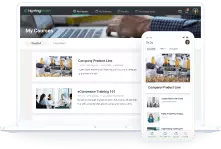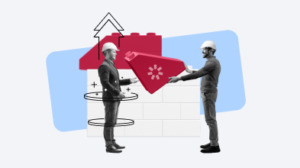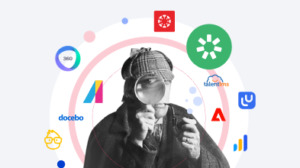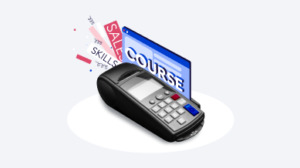eLearning for Sales Training: Tips, Techniques and Use Cases

Without a constant flow of sales, any business will eventually wither on the vine just like a ficus that you forgot to water before you went on vacation. In this article, we’ll tell you how eLearning can help your salespeople close lucrative deals.
Twenty years ago, it was hard to imagine high-quality training being created, managed, and taken via the Internet. Nowadays, online training is creating a consistent learning experience for both general education and field-specific tasks, such as sales rep training.
Why Online Training Is a Must-Have for Sales Reps
To answer the question in the title, we need to take a closer look at people in sales teams. Whether they work in the field or in a call center, it’s always a challenge to get them in a classroom paying attention for an hour or two when a potential sale is waiting, and it can be impossible if there’s no prospect. This is where online training is the key.
- eLearning Makes Learning On-the-Go Possible
Frequent business trips and constant calls make it hard to gather everyone in a class. With eLearning, there’s no need to do that (at least as often), since your staff can educate themselves using their mobile devices wherever they are: in the office, at home, on a plane, or in the subway.
- eLearning Provides Flexibility
While no one denies the importance of live communication and immediate feedback from an instructor, many of the resources and activities that a sales team usually takes can just as effectively be given online. There’s no need to pack learners in classrooms if they can achieve the same results by studying corporate policies or products when it’s convenient for them.
- eLearning Enables Bite-Sized Lessons
Strategies such as content chunking or microlearning naturally go along with effective online sales rep training. Short (usually, up to 5 minutes long) regular lessons fit into their hectic schedules and keep their attention focused. Plus, they can quickly put the obtained knowledge into practice, and that has always been the best way to retain information.
What’s more, online training allows you to track your sales team training results in real time to ensure that everyone has learned the necessary content, and your training activities are as effective as possible.
5 Best Use Cases for eLearning in Sales Training
The truth is, online learning, just like any other tool, isn’t a magic bullet. Still, according to iSpring’s experience in training their own employees, there are at least five situations where eLearning shows brilliant results.
Use case #1: Onboarding
The bad news is that no single theoretical course, even a very good one, can turn a newbie into a wolf of Wall Street. To let newly-hired sales reps succeed, you’ll need to have a holistic view of the process and create an effective onboarding plan. The good news is that onboarding is mostly a standardized process, and eLearning is great for that.
A real-life example:
The onboarding plan for sales reps at iSpring was designed in a large Excel table. It includes information on what a starter should study, which courses to take, and what KPI’s to achieve each week. Here’s what the plan for the first two weeks looks like:
| Weeks 1–2 | |
| Goals and objectives of the week |
|
| Knowledge and skills of the week | An employee is…
|
| Instructor | Head of Quality Assurance |
| To-Do |
|
| To Read | SPIN Selling by Neil Rackham “Client relations” (an in-house series of emails) |
| To Watch | The movie “Boiler Room” |
| Knowledge Check |
– test about the company – test about the industry – test on the technological context – test on the standard of speech |
The first two weeks at the iSpring sales team are fully educational. The employee becomes familiar with the products, dives into the eLearning industry, and finds out who iSpring’s customers are and what they do.
The following week, the next set of training materials and activitie/s is provided. The activities aren’t limited to e-courses; these include meet-ups with a buddy, role-playing games, and listening to call recordings of experienced colleagues.
Every week, they add more actual tasks to the training. The tasks are offered from simple to complex: at first, the newly-hired employees respond to requests via email, then they learn how to work in a chat, and only then do they communicate with clients by phone. There’s a detailed plan for each week for two months.
Use case #2: Product training
Imagine you’ve hired new employees and need to quickly familiarize them with your company’s product. They should know it front to back, its advantages, its strong and weak points, and how to present it to prospects.
One possible solution is assigning this task to buddies among the experienced employees. However, the need to repeat the same information over and over again is definitely not the most effective use of their time. Find time for creating an e-course once for product knowledge training, and it will bring benefits for a long time.
Plus, any product will be updated sooner or later. An e-course will help to tell everyone about the changes and new features; just upload the information to the training platform and assign it to the team.
A real-life example:
Before a new version of iSpring Suite is released, the training department creates a course that covers all the new features of the toolkit.
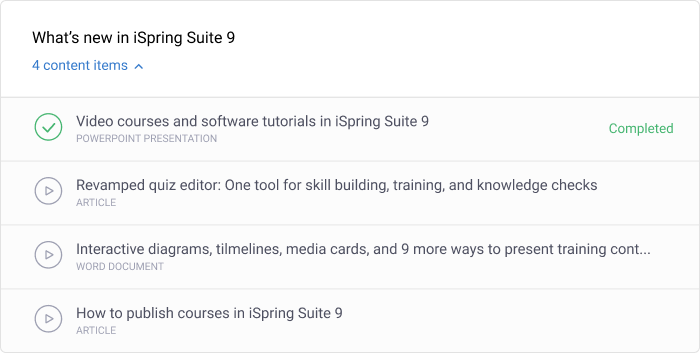
The e-course on the latest version of the iSpring Suite toolkit contains answers to technical questions that can be asked by the clients and will help sales reps better present the updated product.
Use case #3: Standards and best practices
All sales reps in your team should know the standards and approaches that are applied in your company and be able to use the core tools. For example, if you have a CRM system, create a series of video lessons on how to use it; if you require your employees to submit a weekly report on the work they’ve done, make electronic instructions on how to create one, so you won’t have to explain every time what you expect to get.
A real-life example:
At iSpring, the sales process is based on a pipeline. The pipeline is an individual planner of a sales funnel for each employee. It looks like a table with many columns such as Buffer, Decision-maker’s Approval, or Feedback — in other words, it contains information on the most important touchpoints of a deal.
It’s crucial for the employees to be able to add new deals to the pipeline, correctly fill in the client’s cards, and set up activities, so there’s a detailed course that explains every step for a new pipeline user. It contains text instructions with screenshots and two video tutorials: one explains the principles of the pipeline and the other shows how to fill in the information.
There’s also a series of video tutorials on using the CRM and a course that teaches how to set goals and efficiently organize a workday so the employees get the maximum results.
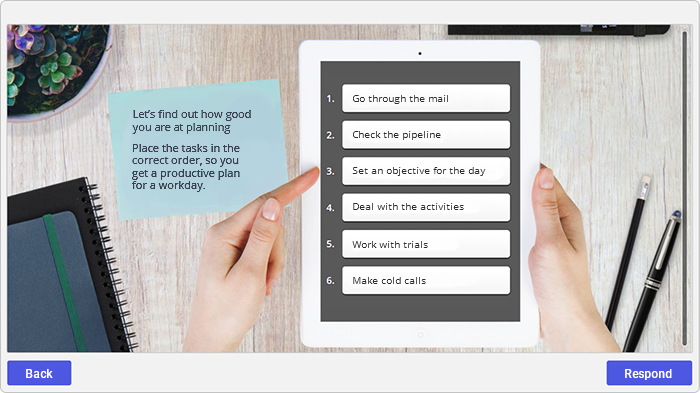
The workday model of an iSpring sales rep helps to efficiently manage time.
Use case #4: Specifics of the industry
eLearning works great when you need to pass on your expertise on the nuances of sales in your company or the industry your company works in. Sales techniques are based on universal principles, but the work of a salesperson differs significantly depending on the industry.
A real-life example:
In the field of software sales, for example, the main tool of sales reps at iSpring is their voices. That’s why one of the obligatory e-courses for iSpring sales reps is dedicated to phone calls.
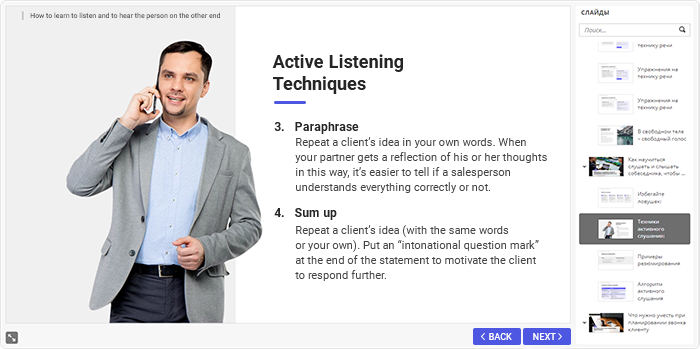
If the characters in your course are real people who work in your company, it creates an additional wow-effect. There’s also the iSpring content library with plenty of high-quality images at your fingertips.
Use Case #5: Performance review
An eLearning portal is of great help when it comes to assessment; it allows you to find out who in your team knows the product inside out and who still can’t name the benefits.
There are two possible options for assessment:
- Routine mode. An employee takes a test after a course to consolidate the knowledge and self-test;
- Certification. The whole department takes the test on the appointed day so the manager can evaluate the situation in the department.
A real-life example:
At iSpring, both options are used. Some courses, for example, courses on basic sales techniques and types of licensing, are naturally followed by a test. Once a year, there’s a mass assessment on the products; it allows the sales reps to brush up on their product knowledge and make sure they’re doing their best when proposing solutions to clients.
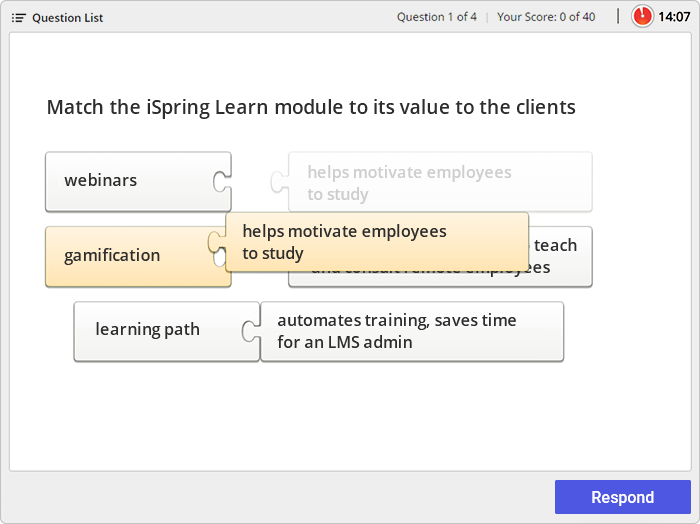
iSpring sales reps take product knowledge tests in the certification mode.
The Limits of eLearning When Training Sales Reps
One of the most popular models for measuring learning effectiveness is the Kirkpatrick model. It consists of four levels of assessment:
Level 1: Reaction — Did students like the training?
Level 2: Learning — What did students learn?
Level 3: Behavior — Was the knowledge put into practice?
Level 4: Results — How did training influence the organization?
Unfortunately, the online training of sales reps, even if it is high quality and based on real-life cases, completely covers only two levels: Reaction and Learning.
Let’s say you created a great interactive course with characters in the company’s branded clothing and added gamification to engage employees in training. If everything worked out and learners said: “Wow, I like it!” you coped with the first level, Reaction.
Online training also does an excellent job with the second level, Learning. For instance, let’s you gave the theory on the steps of the sales process, gave the chance to practice the skill with a virtual client in a dialogue simulation, and then gave a test in order to see what the learners retained after the training.
The third level — what a person does in practice — cannot be covered with eLearning alone. An employee may pass tests with the highest score but never apply the knowledge. When it comes to sales reps, only a mentor who sits next to the employee during a call or listens to call recordings can check whether the employee follows the sales process steps or not with a real customer.
Perhaps it’s impossible for high-quality sales training to do without any live training and mentoring afterwards. For these purposes, you’ll likely need a Customer Relationship Management (CRM) system. Such systems log all interactions with clients, so you can keep an eye on sales processes and monitor the employees’ performance in dynamics after training.
At the same time, one perfectly complements the other; eLearning allows you to focus on the most complex and important aspects of sales during live sessions, rather than spending time on enlisting product features or policies for the umpteenth time.
Conclusion
It might seem that employee training at a company that sells training software must have been perfect right from the start, but that’s not the case, since launching effective corporate training is always an iterative process. For sales rep training, iSpring didn’t completely give up on offline training but adopted a blended approach that combines live sessions and eLearning.
At the same time, eLearning is an important part of the equation. This is a story about minimizing the risk of errors and its consequences in the form of lost customers and therefore lost revenue. Do not miss the opportunity to give your salespeople a chance to practice before sending them on big assignments, since it has now become much easier with eLearning techniques.
